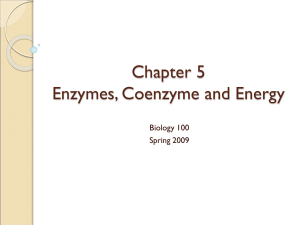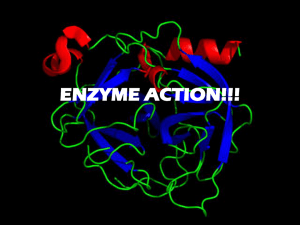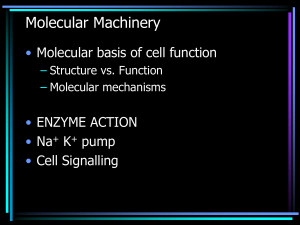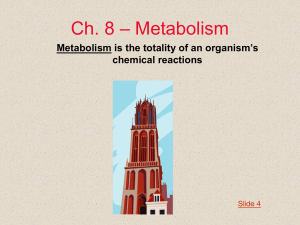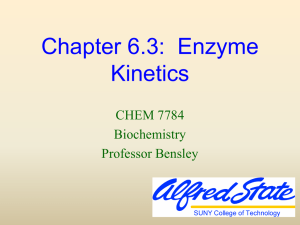Enzymes and Metabolism
advertisement
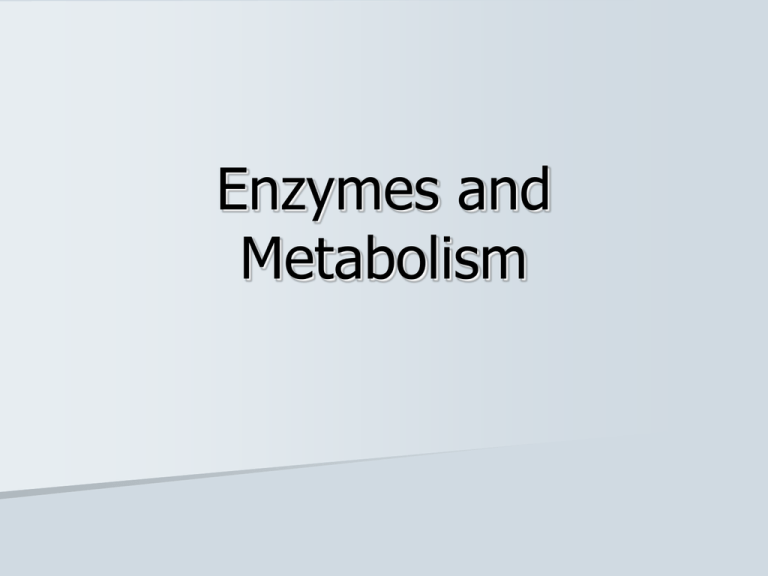
Enzymes and Metabolism Metabolism The sum of all rxns that occur within a cell Rxns either require or produce ATP Rxns that occur within a cell are regulated by the production of specific enzymes (proteins coded by DNA) Metabolic Pathway Series of linked rxns, requiring many enzymes Enzyme 1 Enzyme 2 Enzyme 3 ABCD Substrate Product Substrate Product Substrate Product Thyroid Gland Produces thyroxin (hormone) that functions to: Increase metabolic rate Stimulate all cells (no target organ) Stimulate production of enzyme that breaks down glucose and release NRG More glucose is broken down More NRG is utilized Increase O2 consumption Increase heart rate Cellular Respiration Glucose + O2 CO2 + H2O + ATP Glucose breakdown is exergonic as it creates ATP for use within cells Characteristics of Enzymes 1. 2. 3. 4. 5. Enzyme combine briefly with substrate during rxn Enzymes are released unchanged Enzymes are specific Enzymes are saturated by high [substrate] Enzymes are pH and temperature sensitive Characteristics of Enzyme con’t 6. Enzymes contain protein & non-protein groups called: Substrate Cofactor/coenzyme (nonprotein part) Apoenzyme (protein part) Active Site – area on enzyme where substrate binds on to Enzyme Inhibition Competitive Inhibiton Uncreative molecule that resembles the substrate combines with active site of enzyme Block access of normal substrate so rxn rate slows down Non-competitive Inhibitors Inhibitors that bind to enzyme outside of active site (ex. Poisons, toxins) AKA: Allosteric Inhibitors – bind to site other than active site, resulting in a shape change of enzyme enzyme = no function Substrate Active site Allosteric inhibitor Allosteric site enzyme Changed the shape of active site How is homeostasis maintained? How do cells control the level of activity of enzymes within the cell? Feedback Inhibition (Negative Feedback) Competitive Inhibition When product is in abundance in cell, it binds to the active site of the enzyme, competing for space with the substrate. Rxn rate decreases. Non-permanent binding – when the [product] is lowered, the product leaves active site to allow more substrate to bind. In this way, the [product] stays within a certain range Feedback Inhibition (Negative Feedback) Non-Competitive Inhibition Within metabolic pathway, the end product can also bind to an allosteric site of the first enzyme in the pathway. This binding causes a change in the enzyme's shape and it can no longer function, decreasing the rxn rate D Binds to E1 therefore entire rxn stops A B C D E1 E2 E3 Internet Video Enzyme Review Enzyme Song Provincial Questions What is structure Y? A. a product B. a reactant C. an active site D. an enzyme-substrate complex Competitive inhibitors bind to which structure? A. W B. X C. Y D. Z The changes shown in the diagram cause the rate of an enzyme-catalyzed reaction to decrease because A. the enzyme denatures the substrate. B. the substrate cannot bind to the active site. C. the coenzyme is unable to bind to the substrate. D. the enzyme can no longer increase the activation energy. Which of the following describes the function of an enzyme? A. It speeds up a chemical reaction. B. It increases the available substrate. C. It increases the activation energy of a reaction. D. It contributes atoms to facilitate a chemical reaction.





